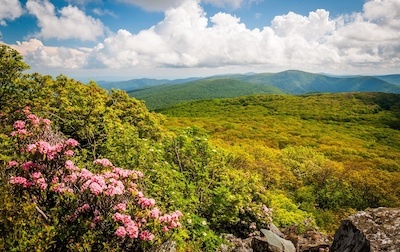
~ Press release issued by the U.S. Department of Agriculture, Forest Service
ROANOKE, Feb. 7 — The USDA has awarded Joint Chiefs’ Landscape Restoration funding to the George Washington and Jefferson National Forest to restore forest health in the Eastern Divide Restoration Project area.
The Joint Chiefs’ Landscape Restoration Partnership enables the Natural Resources Conservation Service and Forest Service, both agencies under the USDA, to collaborate with agricultural producers and forest landowners to invest in conservation and restoration at a big enough scale to make a difference. Working in partnership helps reduce wildfire threats, protect water quality and supply, and improve wildlife habitat for at-risk species.
The award funds a three-year project aimed at improving forest health, habitat, and water quality across public and private lands in Virginia’s Botetourt, Craig, Roanoke, Giles, Bland, Pulaski, Wythe, Tazewell, and Montgomery counties. The project will focus on the 440,724 acres of national forest system lands and 1,819,756 acres of private land in Bland, Botetourt and Wythe counties, where unfragmented oak and pine forests are recognized as a hotspot for biodiversity in the Central Appalachians.
The area contains four of the main watersheds in Virginia (James, Roanoke, New, and Clinch Powell) as well as 559 miles of cold-water trout habitat. The Virginia Department of Conservation and Recreation-Natural Heritage Division tracks 56 species of rare, threatened, and endangered species in the project area, including 32 federally endangered species. Of the 32 federally endangered and threatened species, 28 are aquatic fish or mollusks.
A key aspect of the project restoration work will include prescribed burns, timber stand improvements, and vegetation management treatments that create and promote early successional and open woodland habitat. This habitat is critical for forest bats, grouse, wild turkey, deer, wood turtles, and early successional birds such as the golden-winged warbler.
Through the three-year project, landowners will work with local USDA experts and partners to apply targeted forestry management practices on their land to meet unique forestry challenges in their area.
“This important funding enables us to work across boundaries to improve forest health and wildlife habitat in an important ecosystem,” says Joby Timm, Forest Supervisor.
The Forest is also implementing the third year of Joint Chief’s funding for the North Shenandoah Restoration Project which was first granted the award in 2020. The project aims to improve forest health and resilience landscape around North Shenandoah Mountain in Rockingham County.
For more information about the Joint Chiefs’ Landscape Restoration Project visit: https://www.nrcs.usda.gov/wps/portal/nrcs/detail/national/programs/initiatives/?cid=stelprdb1244394
For more information about the George Washington and Jefferson National Forests visit our website www.fs.fed.us/r8/gwj or follow us on twitter: https://twitter.com/GWJNF.
•••
RELATED ARTICLES
Shenandoah National Park releases Old Rag day-use tickets starting Feb. 1
Virginia State Parks Youth Conservation Corps accepting applications
Forest Service closing seasonal recreation sites and roads for winter
Land Trust of Virginia expands to Page County with Weaver Hollow Conservation Easement
Supervisors approve rezoning, permit for Outlanders’ sale and $30M expansion
Soil and Water Conservation District selects first Conservationist of the Year from Page



Be the first to comment